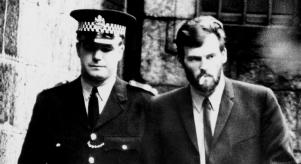
The Pembrokeshire murders
The Pembrokeshire murders
It took twenty-five-years of police investigation and forensic research to finally bring to book a killer who behind the facade of family-man respectability was, in reality, a violent robber, callous rapist and four times murderer, with a penchant for brutality that verged on the pathological.
John Williams Copper was in public a genial and friendly character to friends and the outside world but to his family, he was a controlling thug with an explosive temper. The Welshman from Milford Haven, Pembrokeshire, even presented his curly-haired avuncular side to the nation through television quiz shows, notably ITV’s Bullseye in the late ’80s. Behind the happy-go-lucky mask of a good looking and ordinary citizen was a capacity for cruelty and extreme violence. The psychopath’s sadism wasn’t just reserved for vulnerable strangers he chose to rob but was also inflicted on close family members and the pet dog.
Cooper’s heinous crimes between 1985 to 89 cast a menacing shadow across a small rural part of south-west Wales for a quarter of a century. It is a unique and disturbing case in that it took over two decades to bring the serial killer to justice. Fourteen of those years were spent serving time for robbery towards the latter end of Cooper’s incarceration, giving the police a limited time frame to search for crucial forensic evidence that would link him to two double murders and the sexual assault of two teenage girls.
Pembrokeshire in southwest Wales is renowned for its outstanding coastal beauty and nature trails. In June 1989 it became the unlikely scene of horror after the vicious robbery and murder of middle-aged couple Peter and Gwenda Dixon who were holidaying in the area near Milton Haven. The savage attack by Cooper using a shotgun left some police officers traumatised by the handiwork of a killer who lacked humanity and was unafraid to use violence to the extreme. The headline-grabbing double murder in such an idyllic part of the country was the beginning of an investigation that would eventually present the police with another double murder, one that had taken place five years before.
Peter and Gwenda Dixon had been holidaying away from their home in Witney, Oxfordshire setting up camp at the Howelston Camping and Caravan Park near Little Haven that offered stunning views of the Pembrokeshire coast. On the morning of June 29, 1989 they were enjoying their last day in the area and decided to dry out their tent while they went for a walk on one of the popular coastline paths. Shortly afterwards this peaceful idyllic holiday, turned into a nightmare when they were confronted by the terrifying sight of Cooper, dressed in black with a balaclava over his head and brandishing a shotgun.
Facing evil
One can only imagine the terror the couple suffered looking into Cooper’s demonic eyes as they were tied up and robbed with the shotgun pointing at their heads. Peter was forced to hand over his bank card together with the PIN number. Both terrified victims were shot at close range, one before the other so that whoever died last must have known their terrible fate. In total Cooper fired five times, continuing to shoot sadistically at the already dead bodies which were not discovered until five days later when their worried son contacted the Dyfed Powys Police to report his missing parents. The couple had been brutally murdered for just £300.
Officers were emotionally affected by what they witnessed
Traumatised police
At the scene of the murder where Cooper had attempted to hide the bodies under bracken and bush, Det Supt Aldwyn Jones admitted that officers were emotionally affected by what they witnessed due to the appalling facial injuries inflicted on the Dixons. Such a brutal and inexplicable murder of a harmless middle-aged couple in a peaceful rural setting fuelled conspiracies including theories that Peter and Gwenda may have interrupted a drug gang or had stumbled on an ammunition and weapons cache by the likes of the IRA or members of a criminal gang. The shocking double murder, sickening in its violence immediately sparked a massive manhunt and the gathering of an insurmountable amount of forensic work which in 1989 was unable to benefit from advanced DNA testing. Luckily the majority of artefacts were archived and preserved for future analysis when that technology became available.
Unlinked murders
Four years before the Pembrokeshire murders Cooper had carried out his first double killing with equal ferocity. On 22nd December 1985 the psychopath decided to rob a three-story farmhouse at Scoveston Park, Milford Haven owned by middle-aged siblings Richard and Helen Thomas. The brutal and gratuitously sadistic attack on the pair was assumed by the police at the time to have been a robbery gone wrong. Similar to the trademark violence later played out in 1989, Cooper had threatened his victims with a shotgun before tying them up, robbing and then shooting them both at close range. He then set fire to the house in order to destroy evidence of the crime at a time when DNA technology was still several years from being developed.
Cooper maintained the image of a family man who liked a flutter. His gambling was prodigious and despite winning money he also quickly lost it resulting in his moods changing violently, as witnessed and experienced by Cooper’s young son and terrified mother. According to his son in a television documentary, Cooper never shared his winnings with his family and quickly went through a win of £70,000 leading yet again to desperation to find money.
Battering of a family pet
Years later in interviews, Cooper’s adult son revealed that he had been beaten regularly for the most minor of transgressions, constantly ‘bounced off the walls’ and at one point when just 11 years of age feared for his life when his sadistic father pointed a shotgun at his face, close range and taunted the terrified boy as his cowardly tormentor pulled the trigger. A family pet dog, having gone lame through old age was taken into the back garden by Cooper and beaten to death for half an hour rather than having the defenceless creature put down humanely at a vet. During these years where Cooper acted as a controlling tyrant at home he was also making a name for himself as a competitor on TV Quiz shows.
Some four years after the horrific killing of siblings Richard and Helen Thomas in Milford Haven, the narcissistic side of Cooper led him to appear as a contestant on the popular darts show Bullseye. Presented by the jocular Jim Bowen, Cooper exchanged trivialities revealing to the nation that his ‘unusual’ hobby was scuba diving. The curly-haired and seemingly ordinary contestant hid from millions of TV viewers the darkest of secrets, that he was in fact a sadistic and brutal killer of two people who was yet to carry out another horrific double murder in less than four weeks after the TV show was recorded. Whether Cooper made appearances on television out of vanity, a need for money or self-belief in his deluded sense of invincibility - the irony is that his Bullseye appearance was to be his undoing a few years down the line.
Violent robberies
Due to a spree of armed house robberies in the local area, Cooper was soon on the police radar and his details logged as a violent criminal, known to use extreme force without provocation. In 1998 he was arrested after 30 robberies and violent assault. Still not known as a killer he was sentenced to 14 years in prison. In one house robbery, Cooper had terrified a lone elderly woman. Even after tying her up and beating her with his shotgun, she managed to raise the alarm causing Cooper to flee. In a rare moment of panic, he ditched his balaclava and gloves in a hedgerow which police later retrieved. The botched robbery and the discarding of his tools led police to identify and arrest him. Items officers found at Cooper’s house, including a pair of khaki shorts taken from his bedroom wouldn’t become significant for another decade. Meanwhile, with Cooper residing in prison and with remand meaning a lighter sentence than originally given, the clock was ticking down to the release of a sadistic killer back on the streets and one who may take to killing again for a few pounds.
Operation Ottawa
In 2006 a group of detectives known as Operation Ottawa were tasked with investigating three previously unlinked crimes. Among them was the Dixon murder. One of the other double murders was the horrific attack on siblings Helen and Richard Thomas in 1985, who like the Dixons had been tied up and robbed before being blasted to death with a shotgun. With no forensic evidence to point to a suspect, the crimes had remained in the cold case files. A third crime the Ottawa team looked at was an appalling attack in March 1996 on a group of teenagers in a field behind the Mount Estate, Milford Haven. Forced to lie face down by a hooded man threatening the youngsters with a shotgun, a 16-year-old girl was raped and a 15-year-old sexually assaulted by him. The cowardly attacker again was John William Cooper.
It took another two years of collating witness statements and scrutinising thousands of old exhibits before the Ottawa team were convinced that the same person was responsible for all three crimes. Such a person they believed had the ability to control multiple victims, understood the rural area and was unafraid to use extreme violence at the hands of a shotgun. Two of the crimes, that of the Thomas murders and the attack on the teenagers were in close proximity to each other.
One name that kept cropping up was Cooper’s. The police noted that the armed house burglaries he was convicted of in 1998 covered the same geographical area as all the three unlinked crimes the Ottawa team were investigating. It wasn’t long before Cooper became the prime suspect in all three crimes, particularly as his criminal record for violent burglary using a shotgun convinced police officers that they had their man. Once it was known that Cooper had appeared on the TV show Bullseye, meticulous scrutinising of the studio footage and comparing Cooper’s image with that of the police sketch contributed to a belief that Cooper was the killer. But the major stumbling block to making an official arrest and charging Cooper with murder was obtaining that vital nugget of forensic evidence linking him to the attack on the Dixons in 1989. The police were aware that Cooper was nearing his release date from prison. Time was of the essence to keep him in prison for life. In January 2009 after just 11 years of serving time Cooper was released. Less than three months later he re-arrested in a dramatic sting on the street as police officers bundled the agitated and aggressive serial killer into a police car. They had found evidence to bring him back into custody. In Cooper’s private car the police uncovered a disturbing sign of what was to come had he not been apprehended. Newly bought rope and gloves suggested the psychopath was about to continue his deadly spree of murderous attacks on innocent people again.
Crucial police interview
During police interviews the mildly spoken Cooper betraying a soft southern Welsh lilt usually kept calm and was resolute about his innocence. As the days of interviewing went by the subject of Cooper’s shotgun appeared to undermine his confidence. Cooper’s demeanour, often shouting and becoming irate demonstrated a degree of anxiety. But the vital ‘nugget’ was soon to be revealed relating to the pair of khaki shorts taken from Cooper’s bedroom and which bore a resemblance to the shorts worn by a suspect seen at an ATM machine using Peter Dixon’s bank card. The identikit sketch showed a likeness to Cooper. The shorts had in fact been taken from the Dixons' rucksack and belonged to the murdered couple’s daughter.
Murder trophy secrets
Whether Cooper couldn’t resist taking a ‘trophy’ as a macabre reminder of his violent crime or because he simply thought the shorts would be useful to wear, it was Cooper’s own insistence in a police interview that the shorts in the suspect picture were longer than the ones in his possession that led to a breakthrough. Dr Angela Gallop of LGC Forensics played a major role in discovering vital evidence from the shorts. Having been alerted to the fact that the ones taken from Cooper’s house were shorter in length, Gallop and her team unpicked the stitching and discovered that they had originally been longer. Cooper’s wife had shortened them some years before. Within the lining of the folds vital fibres were found that matched the scene of the crime on the Pembrokeshire walking trail where the Dixons had been murdered. More importantly was a minute speck of blood on the shorts, previously hidden, that the lab team were able to extract a DNA profile from. It matched that of Peter Dixon. Unable to explain how his shorts had DNA evidence from Dixon, police were astonished by the way Cooper unashamedly passed the blame onto his innocent son by suggesting that the young lad would borrow his shorts. Despite Cooper’s pitiful attempt to implicate his own son in the double murder the shotgun itself revealed Peter Dixon’s blood under black paint along the gun’s barrel. Cooper had simply painted the gun believing it would obliterate any evidence of the crime.
Trial
On his way into court to be tried for four counts of murder including rape, Cooper shouted at the press ‘Judge me after the trial and not before!’ The evidence from the khaki shorts and the shotgun revealing DNA of murdered victim Peter Dixon was damning. Cooper’s own son acted for the prosecution via video link and the traumatised teenagers attacked and sexually assaulted by Cooper in 1996 also gave evidence in an emotional testimony about how the psychotic brute had terrified them and changed them forever. Cooper received Life Imprisonment, a whole life order and incarcerated without parole in May 2011.




